Page 370 of 474
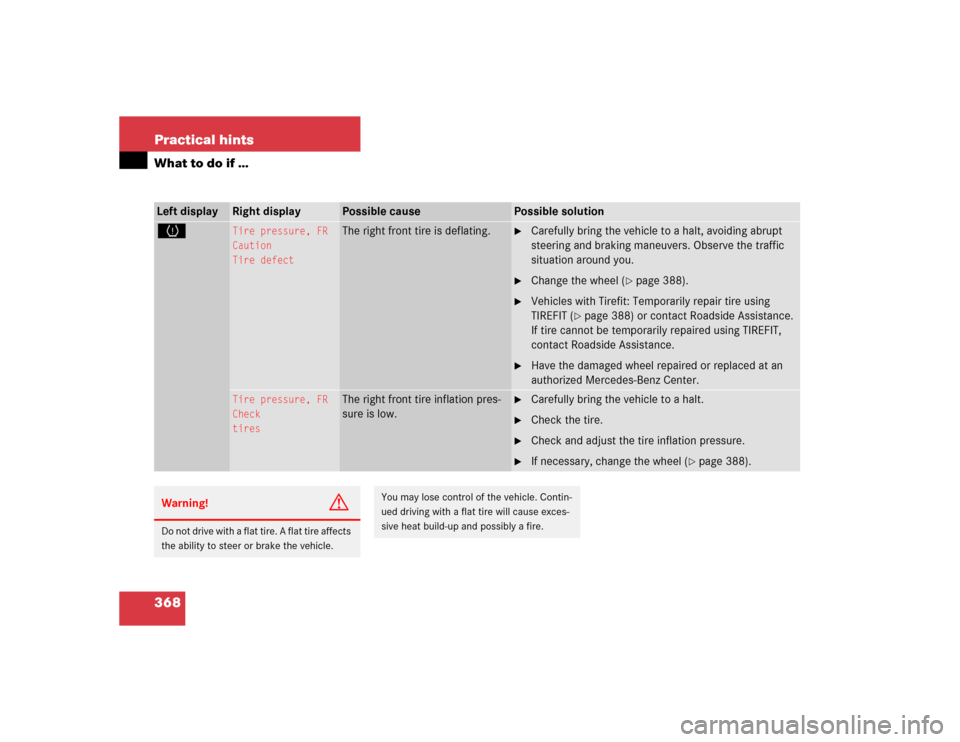
368 Practical hintsWhat to do if …Left display
Right display
Possible cause
Possible solution
H
Tire pressure, FR
Caution
Tire defect
The right front tire is deflating.
�
Carefully bring the vehicle to a halt, avoiding abrupt
steering and braking maneuvers. Observe the traffic
situation around you.
�
Change the wheel (
�page 388).
�
Vehicles with Tirefit: Temporarily repair tire using
TIREFIT (
�page 388) or contact Roadside Assistance.
If tire cannot be temporarily repaired using TIREFIT,
contact Roadside Assistance.
�
Have the damaged wheel repaired or replaced at an
authorized Mercedes-Benz Center.
Tire pressure, FR
Check
tires
The right front tire inflation pres-
sure is low.
�
Carefully bring the vehicle to a halt.
�
Check the tire.
�
Check and adjust the tire inflation pressure.
�
If necessary, change the wheel (
�page 388).
Warning!
G
Do not drive with a flat tire. A flat tire affects
the ability to steer or brake the vehicle.
You may lose control of the vehicle. Contin-
ued driving with a flat tire will cause exces-
sive heat build-up and possibly a fire.
Page 371 of 474
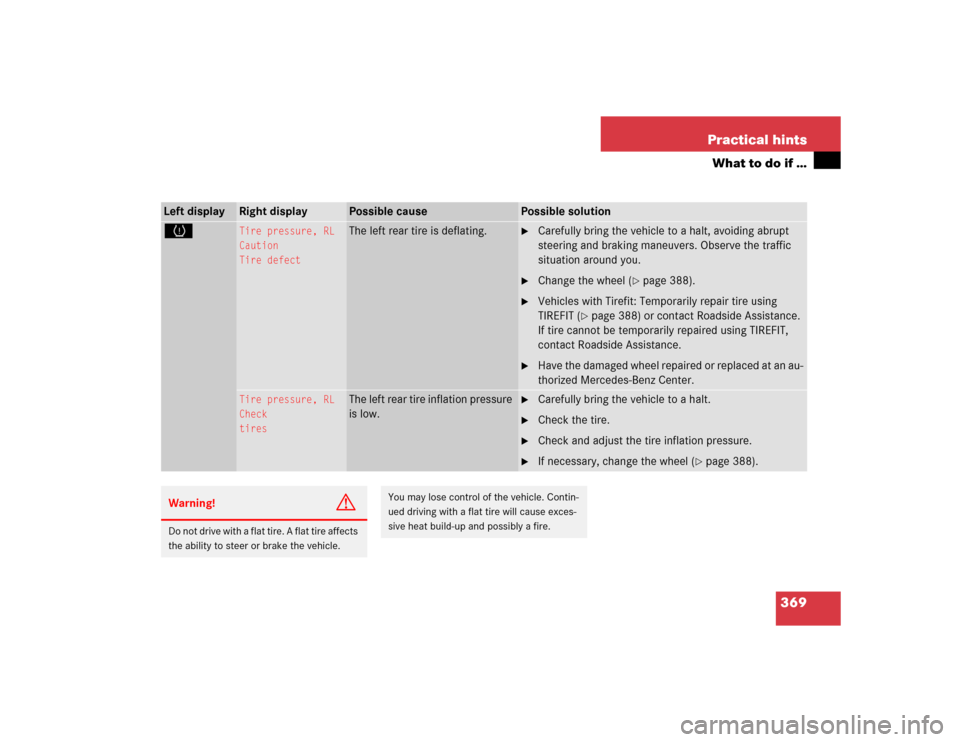
369 Practical hints
What to do if …
Left display
Right display
Possible cause
Possible solution
H
Tire pressure, RL
Caution
Tire defect
The left rear tire is deflating.
�
Carefully bring the vehicle to a halt, avoiding abrupt
steering and braking maneuvers. Observe the traffic
situation around you.
�
Change the wheel (
�page 388).
�
Vehicles with Tirefit: Temporarily repair tire using
TIREFIT (
�page 388) or contact Roadside Assistance.
If tire cannot be temporarily repaired using TIREFIT,
contact Roadside Assistance.
�
Have the damaged wheel repaired or replaced at an au-
thorized Mercedes-Benz Center.
Tire pressure, RL
Check
tires
The left rear tire inflation pressure
is low.
�
Carefully bring the vehicle to a halt.
�
Check the tire.
�
Check and adjust the tire inflation pressure.
�
If necessary, change the wheel (
�page 388).
Warning!
G
Do not drive with a flat tire. A flat tire affects
the ability to steer or brake the vehicle.
You may lose control of the vehicle. Contin-
ued driving with a flat tire will cause exces-
sive heat build-up and possibly a fire.
Page 372 of 474
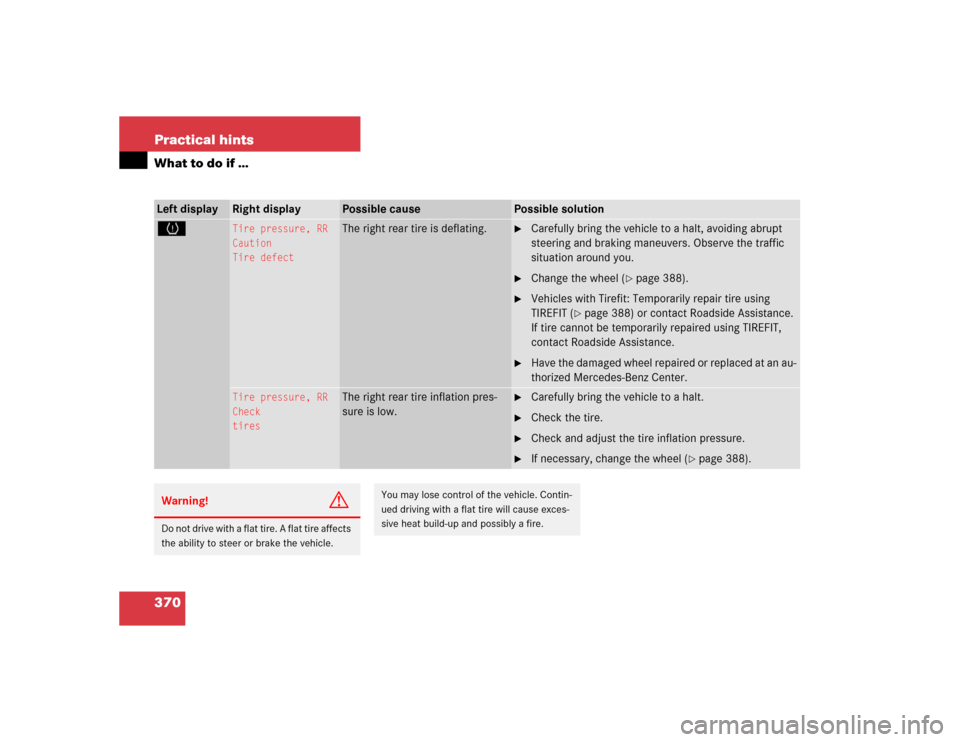
370 Practical hintsWhat to do if …Left display
Right display
Possible cause
Possible solution
H
Tire pressure, RR
Caution
Tire defect
The right rear tire is deflating.
�
Carefully bring the vehicle to a halt, avoiding abrupt
steering and braking maneuvers. Observe the traffic
situation around you.
�
Change the wheel (
�page 388).
�
Vehicles with Tirefit: Temporarily repair tire using
TIREFIT (
�page 388) or contact Roadside Assistance.
If tire cannot be temporarily repaired using TIREFIT,
contact Roadside Assistance.
�
Have the damaged wheel repaired or replaced at an au-
thorized Mercedes-Benz Center.
Tire pressure, RR
Check
tires
The right rear tire inflation pres-
sure is low.
�
Carefully bring the vehicle to a halt.
�
Check the tire.
�
Check and adjust the tire inflation pressure.
�
If necessary, change the wheel (
�page 388).
Warning!
G
Do not drive with a flat tire. A flat tire affects
the ability to steer or brake the vehicle.
You may lose control of the vehicle. Contin-
ued driving with a flat tire will cause exces-
sive heat build-up and possibly a fire.
Page 390 of 474
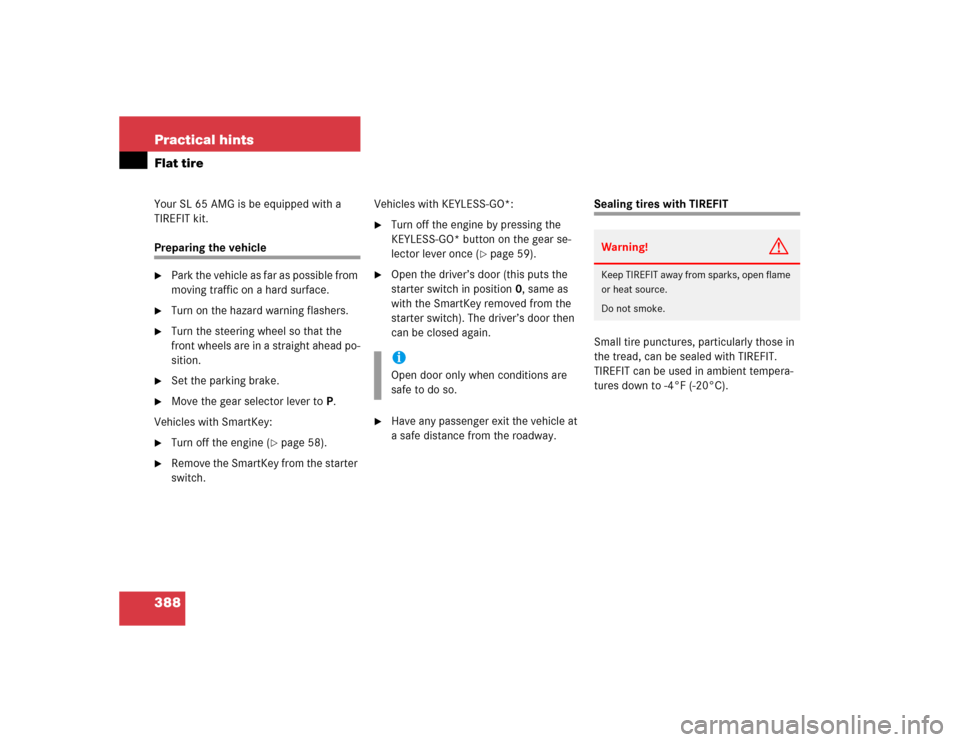
388 Practical hintsFlat tireYour SL 65 AMG is be equipped with a
TIREFIT kit.Preparing the vehicle�
Park the vehicle as far as possible from
moving traffic on a hard surface.
�
Turn on the hazard warning flashers.
�
Turn the steering wheel so that the
front wheels are in a straight ahead po-
sition.
�
Set the parking brake.
�
Move the gear selector lever to P.
Vehicles with SmartKey:
�
Turn off the engine (
�page 58).
�
Remove the SmartKey from the starter
switch.Vehicles with KEYLESS-GO*:
�
Turn off the engine by pressing the
KEYLESS-GO* button on the gear se-
lector lever once (
�page 59).
�
Open the driver’s door (this puts the
starter switch in position 0, same as
with the SmartKey removed from the
starter switch). The driver’s door then
can be closed again.
�
Have any passenger exit the vehicle at
a safe distance from the roadway.
Sealing tires with TIREFIT
Small tire punctures, particularly those in
the tread, can be sealed with TIREFIT.
TIREFIT can be used in ambient tempera-
tures down to -4°F (-20°C).
iOpen door only when conditions are
safe to do so.
Warning!
G
Keep TIREFIT away from sparks, open flame
or heat source.
Do not smoke.
Page 411 of 474
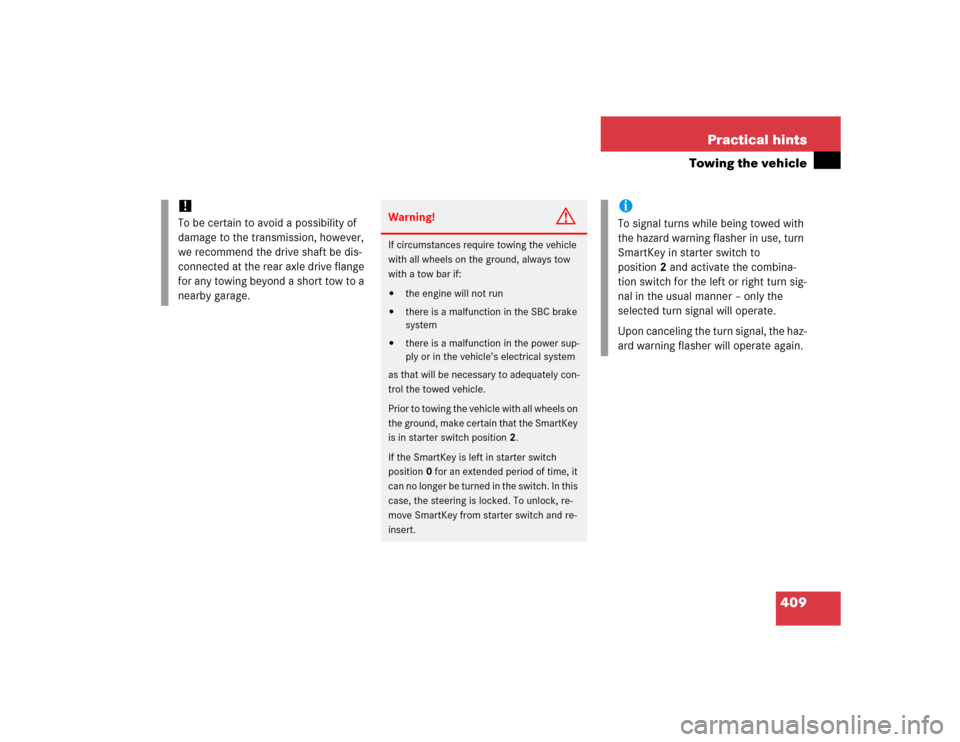
409 Practical hints
Towing the vehicle
!
To be certain to avoid a possibility of
damage to the transmission, however,
we recommend the drive shaft be dis-
connected at the rear axle drive flange
for any towing beyond a short tow to a
nearby garage.
Warning!
G
If circumstances require towing the vehicle
with all wheels on the ground, always tow
with a tow bar if:�
the engine will not run
�
there is a malfunction in the SBC brake
system
�
there is a malfunction in the power sup-
ply or in the vehicle’s electrical system
as that will be necessary to adequately con-
trol the towed vehicle.
Prior to towing the vehicle with all wheels on
the ground, make certain that the SmartKey
is in starter switch position2.
If the SmartKey is left in starter switch
position0 for an extended period of time, it
can no longer be turned in the switch. In this
case, the steering is locked. To unlock, re-
move SmartKey from starter switch and re-
insert.
iTo signal turns while being towed with
the hazard warning flasher in use, turn
SmartKey in starter switch to
position2 and activate the combina-
tion switch for the left or right turn sig-
nal in the usual manner – only the
selected turn signal will operate.
Upon canceling the turn signal, the haz-
ard warning flasher will operate again.
Page 412 of 474
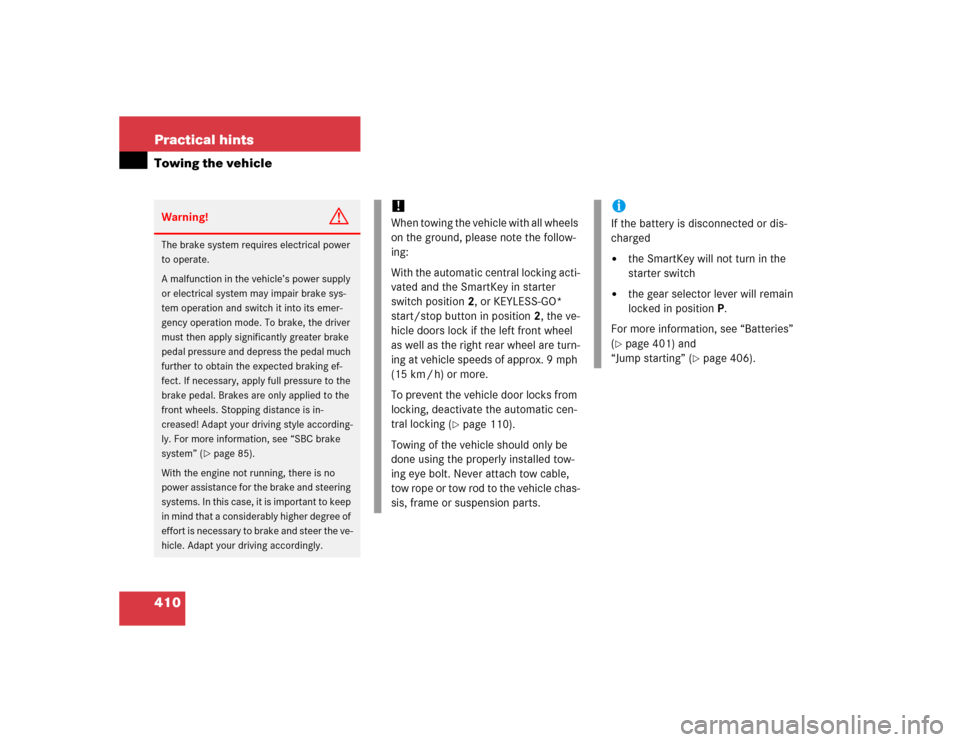
410 Practical hintsTowing the vehicleWarning!
G
The brake system requires electrical power
to operate.
A malfunction in the vehicle’s power supply
or electrical system may impair brake sys-
tem operation and switch it into its emer-
gency operation mode. To brake, the driver
must then apply significantly greater brake
pedal pressure and depress the pedal much
further to obtain the expected braking ef-
fect. If necessary, apply full pressure to the
brake pedal. Brakes are only applied to the
front wheels. Stopping distance is in-
creased! Adapt your driving style according-
ly. For more information, see “SBC brake
system” (
�page 85).
With the engine not running, there is no
power assistance for the brake and steering
systems. In this case, it is important to keep
in mind that a considerably higher degree of
effort is necessary to brake and steer the ve-
hicle. Adapt your driving accordingly.
!When towing the vehicle with all wheels
on the ground, please note the follow-
ing:
With the automatic central locking acti-
vated and the SmartKey in starter
switch position2, or KEYLESS-GO*
start/stop button in position2, the ve-
hicle doors lock if the left front wheel
as well as the right rear wheel are turn-
ing at vehicle speeds of approx. 9 mph
(15 km / h) or more.
To prevent the vehicle door locks from
locking, deactivate the automatic cen-
tral locking (
�page 110).
Towing of the vehicle should only be
done using the properly installed tow-
ing eye bolt. Never attach tow cable,
tow rope or tow rod to the vehicle chas-
sis, frame or suspension parts.
iIf the battery is disconnected or dis-
charged�
the SmartKey will not turn in the
starter switch
�
the gear selector lever will remain
locked in positionP.
For more information, see “Batteries”
(
�page 401) and
“Jump starting” (
�page 406).
Page 433 of 474
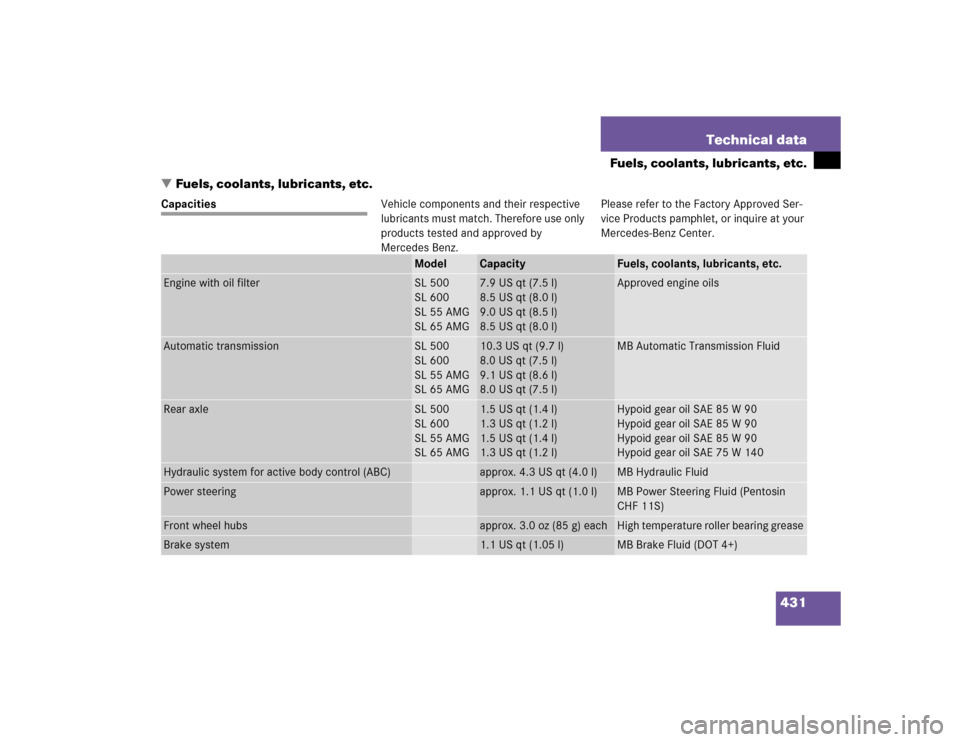
431 Technical data
Fuels, coolants, lubricants, etc.
�Fuels, coolants, lubricants, etc.
CapacitiesVehicle components and their respective
lubricants must match. Therefore use only
products tested and approved by
Mercedes Benz.Please refer to the Factory Approved Ser-
vice Products pamphlet, or inquire at your
Mercedes-Benz Center.
Model
Capacity
Fuels, coolants, lubricants, etc.
Engine with oil filter
SL 500
SL 600
SL 55 AMG
SL 65 AMG
7.9 US qt (7.5 l)
8.5 US qt (8.0 l)
9.0 US qt (8.5 l)
8.5 US qt (8.0 l)
Approved engine oils
Automatic transmission
SL 500
SL 600
SL 55 AMG
SL 65 AMG
10.3 US qt (9.7 l)
8.0 US qt (7.5 l)
9.1 US qt (8.6 l)
8.0 US qt (7.5 l)
MB Automatic Transmission Fluid
Rear axle
SL 500
SL 600
SL 55 AMG
SL 65 AMG
1.5 US qt (1.4 l)
1.3 US qt (1.2 l)
1.5 US qt (1.4 l)
1.3 US qt (1.2 l)
Hypoid gear oil SAE 85 W 90
Hypoid gear oil SAE 85 W 90
Hypoid gear oil SAE 85 W 90
Hypoid gear oil SAE 75 W 140
Hydraulic system for active body control (ABC)
approx. 4.3 US qt (4.0 l)
MB Hydraulic Fluid
Power steering
approx. 1.1 US qt (1.0 l)
MB Power Steering Fluid (Pentosin
CHF 11S)
Front wheel hubs
approx. 3.0 oz (85 g) each
High temperature roller bearing grease
Brake system
1.1 US qt (1.05 l)
MB Brake Fluid (DOT 4+)
Page 442 of 474

440 Technical termsCAN system
(C
ontroller A
rea N
etwork)
Data bus network serving to control ve-
hicle functions such as door locking or
windshield wiping depending on vehi-
cle settings and/or ambient condi-
tions.
Cockpit
All instruments, switches, buttons and
indicator/warning lamps in the passen-
ger compartment needed for vehicle
operation and monitoring.
Collapsible tire
An especially compact spare tire that
must be inflated with a provided air
pump before using. It should only be
used to bring the vehicle to the nearest
service station.COMAND
(Co
ckpit Man
agement and
D
ata System)
Information and operating center for
vehicle sound and communications
systems, including the radio, CD
changer and navigation system, as well
as other optional equipment (e.g. tele-
phone).
Control system
The control system is used to call up
vehicle information and to change
component settings. Information and
messages appear in the multifunction
display. The driver uses the buttons on
the multifunction steering wheel to
navigate through the system and to ad-
just settings.
Cruise control
Driving convenience system for auto-
matically maintaining the vehicle speed
set by the driver.Distronic*
A driving convenience cruise control
system which helps the driver maintain
a pre-selected speed:
�
If there is no vehicle directly ahead,
the system operates in the same
way as conventional cruise control.
�
If a slower moving vehicle is ahead,
Distronic* will reduce your vehicle
speed to the extent permitted by re-
duced throttle and up to 20% brak-
ing power to maintain the preset
minimum following distance.
DTR
(->Distr
onic*)
Engine number
The number set by the manufacturer
and placed on the cylinder block to
uniquely identify each engine pro-
duced.